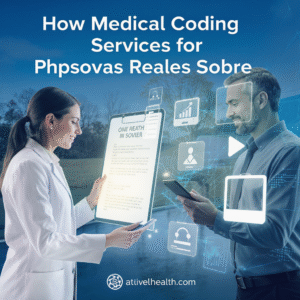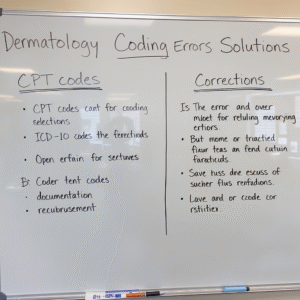Precision & Payouts: Why Interventional Pain Management Needs Expert Coding Services
Coding services
Coding services
Interventional pain management practices are at the forefront of providing relief to millions suffering from chronic and acute pain. From epidural injections and nerve blocks to advanced neuromodulation and regenerative medicine therapies, these procedures require highly specialized skills and complex clinical decision-making. However, the financial viability of these practices often hinges on something less visible but equally critical: accurate and optimized medical coding.

The world of pain management coding is a labyrinth of specific CPT, ICD-10, and HCPCS codes, complex modifier usage, and ever-evolving payer policies. Without expert coding services, interventional pain practices risk leaving significant revenue on the table, facing claim denials, and even running afoul of compliance regulations. In today’s healthcare landscape, where margins are increasingly tight and regulatory scrutiny continues to intensify, precision in coding has become more than just operational necessity—it’s a competitive advantage.
The Current State of Pain Management Practice Economics
The interventional pain management field has experienced remarkable growth over the past decade, driven by an aging population, increased recognition of chronic pain as a significant health issue, and advances in minimally invasive treatment options. However, this growth comes with unique financial challenges that set pain management apart from other medical specialties.
Unlike primary care or general surgery, pain management procedures often involve:
- Multiple anatomical sites treated in a single session
- Complex injection techniques requiring specialized imaging guidance
- Innovative technologies that may not have established billing precedents
- Multidisciplinary approaches combining medical, psychological, and rehabilitative elements
- Chronic conditions requiring ongoing management and careful documentation of treatment progression
These factors create a coding environment where even experienced medical billers can struggle without specialized knowledge of pain management protocols and payer requirements.
The Unique Coding Challenges of Interventional Pain Management
Procedure Complexity and Anatomical Precision
Interventional procedures are highly detailed, requiring coders to accurately capture multiple elements that directly impact reimbursement. Consider a patient receiving bilateral facet joint injections at multiple levels—the coder must correctly identify:
- Specific anatomical locations (cervical, thoracic, or lumbar)
- Exact vertebral levels (C3-C4, L4-L5, etc.)
- Laterality (unilateral vs. bilateral procedures)
- Number of levels treated (single vs. multiple)
- Imaging guidance utilized (fluoroscopy, CT, ultrasound)
- Injection approach (transforaminal, interlaminar, caudal)

A single missing detail or incorrect code selection can result in underpayment or outright denial, potentially costing thousands of dollars per claim.
Modifier Mayhem and Billing Nuances
Pain management relies heavily on modifiers to communicate the complexity and scope of procedures performed. Common scenarios include:
- Modifier 50 for bilateral procedures
- Modifier 59/XS for distinct procedural services
- Modifier 51 for multiple procedures
- Modifier 76 for repeat procedures
- Modifier RT/LT for laterality specification
The challenge intensifies when multiple modifiers are required on a single claim, and payer-specific rules dictate which combinations are acceptable. For example, some insurers may require documentation of medical necessity for bilateral procedures, while others may have frequency limitations that must be carefully tracked.
Advanced Bundling and Unbundling Rules
The National Correct Coding Initiative (NCCI) edits create complex bundling scenarios that are particularly relevant to pain management:
- Fluoroscopic guidance is often bundled with injection procedures and cannot be billed separately
- Multiple injections at the same anatomical region may be subject to bundling rules
- Diagnostic and therapeutic procedures performed on the same day require careful coding to avoid inappropriate bundling
- Trigger point injections have specific rules about the number of muscles that can be billed
Understanding these bundling relationships requires constant vigilance and specialized knowledge that general medical coders may lack.
Evolving Technology and New Procedures
The pain management field continues to innovate, introducing new technologies and treatment modalities that present coding challenges:
- Radiofrequency ablation procedures with new techniques and approaches
- Spinal cord stimulation with advanced programming and revision procedures
- Regenerative medicine treatments like platelet-rich plasma (PRP) and stem cell therapies
- Minimally invasive lumbar decompression (MILD) procedures
- Intrathecal pump management with complex refill and programming requirements
As these technologies evolve, so do the coding requirements, making it essential to work with coders who stay current with industry developments.
Documentation Requirements and Medical Necessity
Pain management procedures face intense scrutiny regarding medical necessity, requiring comprehensive documentation that includes:
- Detailed pain history with functional impact assessments
- Failed conservative treatments with specific timeframes and outcomes
- Imaging correlation supporting the targeted anatomical structures
- Physical examination findings consistent with the planned procedure
- Patient selection criteria demonstrating appropriateness for intervention
- Informed consent documentation with procedure-specific risks and benefits
- Post-procedure monitoring and follow-up plans
Inadequate documentation is one of the leading causes of claim denials and audit findings in pain management practices.
Financial Impact of Coding Inefficiencies
The financial consequences of suboptimal coding in pain management practices can be substantial:
Revenue Leakage Scenarios
- Undercoding: Using less specific codes that result in lower reimbursement rates
- Missed procedures: Failing to capture all billable services provided during a patient encounter
- Modifier errors: Incorrect or missing modifiers that trigger automatic denials
- Bundling mistakes: Billing separately for services that should be bundled, or vice versa
- Frequency violations: Exceeding payer-specific limits on procedure frequency without proper documentation
Studies suggest that practices without specialized coding expertise may lose 15-20% of potential revenue due to these coding inefficiencies.
Administrative Burden Costs
Beyond direct revenue loss, coding errors create significant administrative overhead:
- Claims processing delays requiring staff time for resubmission
- Appeal preparation and management for denied claims
- Payer correspondence regarding claim clarifications
- Audit response preparation for compliance reviews
- Training costs for general coders to learn pain management specifics

How Expert Pain Management Coding Services Unlock Revenue & Boost Reimbursements
Partnering with specialized pain management coding services is a strategic move that can significantly impact your practice’s financial health. Here’s how they deliver tangible benefits:
1. Maximized Reimbursement Through Precision Coding
Expert coders understand the nuances of pain management procedures and can apply the most specific and highest-paying codes that are medically supported by your documentation. This includes:
- Optimizing code selection to capture the full scope of services provided
- Utilizing add-on codes appropriately for multiple levels or bilateral procedures
- Applying correct modifiers to ensure proper payment for complex scenarios
- Identifying overlooked procedures that can be legitimately billed
2. Proactive Denial Prevention
Rather than simply processing claims, expert coding services implement proactive measures to prevent denials:
- Pre-submission reviews to catch potential issues before claims are filed
- Payer-specific formatting to meet individual insurance company requirements
- Documentation audits to ensure medical necessity is clearly established
- Prior authorization tracking to prevent services from being performed without proper approval
3. Enhanced Cash Flow Management
Specialized coding services contribute to improved cash flow through:
- Faster claim processing due to clean claims submission
- Reduced accounts receivable aging through fewer denials and rejections
- Predictable revenue patterns enabling better financial planning
- Optimized collection cycles with fewer payment delays
4. Comprehensive Compliance Protection
Expert services provide multiple layers of compliance protection:
- Regular code updates ensuring use of current CPT, ICD-10, and HCPCS codes
- Payer policy monitoring to stay current with changing reimbursement rules
- Audit preparedness with documentation and coding that withstands scrutiny
- Risk assessment identifying potential compliance vulnerabilities
5. Documentation Enhancement and Provider Education
Professional coding services often collaborate with clinical teams to improve documentation quality:
- Template development for procedure-specific documentation requirements
- Provider training on coding-compliant documentation practices
- Real-time feedback on documentation gaps that could impact reimbursement
- Best practice sharing based on industry benchmarks and payer preferences
6. Technology Integration and Automation
Advanced coding services leverage technology to improve efficiency and accuracy:
- Automated coding suggestions based on documented procedures
- Real-time eligibility verification to prevent coverage issues
- Electronic prior authorization systems to streamline approval processes
- Analytics dashboards providing insights into coding performance and revenue trends
7. Specialized Expertise in Complex Scenarios
Pain management coding services bring deep expertise in handling challenging cases:
- Worker’s compensation claims with state-specific requirements and fee schedules
- Personal injury cases involving lien processing and third-party billing
- Medicare Advantage plans with unique authorization and billing requirements
- Experimental procedures requiring special coding considerations and documentation

Selecting the Right Pain Management Coding Partner
When evaluating coding service providers, consider these critical factors:
Industry Experience and Specialization
- Years of experience specifically in pain management coding
- Certification levels of coding staff (CPC, CCS, RHIA)
- Understanding of interventional pain procedures and anatomy
- Knowledge of pain-specific payer policies and requirements
Technology and Integration Capabilities
- Compatibility with your practice management system
- Real-time reporting and analytics capabilities
- Electronic claims submission and tracking
- Automated denial management workflows
Compliance and Quality Assurance
- Regular internal auditing processes
- Compliance with HIPAA and other regulatory requirements
- Quality metrics and performance reporting
- Error rate tracking and improvement processes
Communication and Support
- Dedicated account management
- Provider education and training programs
- Responsive customer support
- Regular performance reviews and optimization recommendations
The ROI of Expert Pain Management Coding
The return on investment for specialized pain management coding services typically includes:
- 5-15% increase in net collections through optimized coding and reduced denials
- 30-50% reduction in claim denials leading to improved cash flow
- 20-30% decrease in administrative burden allowing staff to focus on patient care
- Improved compliance scores reducing audit risk and potential penalties
- Enhanced provider satisfaction through reduced billing-related stress
Future Trends in Pain Management Coding
Several trends are shaping the future of pain management coding:
Value-Based Care Models
As healthcare moves toward value-based payments, pain management practices must demonstrate:
- Improved patient outcomes
- Cost-effective treatment protocols
- Quality metrics achievement
- Population health management
Artificial Intelligence and Machine Learning
Technology will increasingly assist with:
- Automated code selection based on documentation
- Predictive analytics for denial prevention
- Real-time compliance monitoring
- Outcome tracking and reporting

Regulatory Evolution
Ongoing changes in healthcare regulation will require:
- Continuous education and adaptation
- Enhanced documentation requirements
- New quality reporting measures
- Evolving privacy and security standards
Conclusion: Investing in Coding Excellence
Interventional pain management is a vital and growing field that serves a critical patient population. To thrive in this dynamic environment, practices must ensure their financial operations are as precise as their clinical procedures. Expert pain management coding services are not just an expense; they are a strategic investment that pays dividends in maximized revenue, reduced risk, and a healthier, more focused practice.
The complexity of pain management coding, combined with the high financial stakes involved, makes specialized expertise not just valuable but essential. By partnering with expert coding services, interventional pain management practices can focus on what they do best—providing exceptional patient care—while ensuring their financial foundation remains strong and compliant.
In an era where healthcare economics continue to evolve and regulatory requirements become increasingly complex, the practices that invest in coding excellence will be best positioned for long-term success and sustainability. The question is not whether you can afford expert coding services, but whether you can afford to operate without them.



